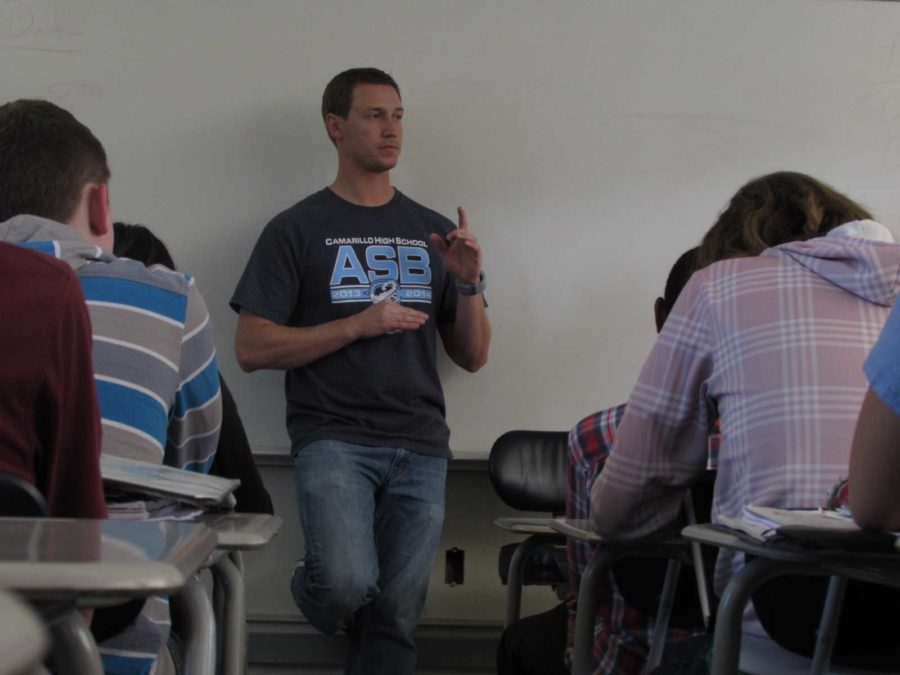APUSH Controversy: College Framework Catastrophe
Mr. Doyle teaches his AP U.S. History classes as he attempts to avoid the controversy in the AP curriculum.
Opponents of the revised 2014-2015 AP U.S. History (APUSH) exam have begun a patriotic uproar against the College Board and its released framework for the modified test.
Teachers and politicians have described the curriculum as “liberally biased” and “radically revisionist,” and claim the course unfairly tests students on an inaccurate depiction of United States history, according to a Newsweek article.
Mr. Larry S. Krieger, an APUSH teacher from New Jersey, said, “As I read through the [framework], I saw a consistently negative view of American history that highlights oppressors and exploiters.” He found that “instead of striving to build a city on a hill,” referring to the American sentiment made famous by John Winthrop, the revised framework “portrayed [our nation’s founders] as bigots.”
Neither Winthrop’s support of American exceptionalism nor his name appears in the framework, despite Winthrop being a leading early American colonial figure and founder of the Massachusetts Bay Colony.
Mr. Matthew Doyle, APUSH teacher at Cam High, said that he understood the controversy. “I can very easily see why conservatives have a problem with it, especially when it doesn’t mention George Washington except for one time, and it doesn’t mention [John] Adams or [Thomas] Jefferson.”
This lack of acknowledgement could lead to teachers hard-pressed on time foregoing discussion on some of America’s most important historical figures. “Nothing that is not on the outline is on the test,” said Doyle. “So a teacher might say, ‘Well, if George Washington is never mentioned on the outline, then I’m not going to teach him because he is not going to be on the test.'”
However, the College Board has stated that significant figures and events omitted from the framework are not necessarily excluded from the test altogether. “Just like the previous framework, the new framework does not remove individuals or events that have been taught by AP teachers in prior years,” said CEO David Coleman. “Instead, it is just a framework, requiring teachers to populate it with content required by their local standards and priorities.”
A recently released full-length practice exam features a series of three questions that exemplify the exam’s prejudices, according to conservatives. Opponents of the new curriculum believe that questions 24 through 26, which are based off of an 1880’s image of New York City slums, force the test taker to lean toward a more liberal viewpoint.

Yet, to some students, the framework does not seem to be biased at all.
“I don’t think the questions are biased because you’re supposed to look at [certain] questions as a person from that time period,” said Brandon Barrosso, a junior currently taking APUSH.
Bella Husted, also a junior taking APUSH, expressed similar sentiments. “I don’t really see [the questions] as that biased, because they’re just going off of the viewpoint of the people from the past.”
The College Board maintains on its Frequently Asked Questions page that the latest reforms to the curriculum were made in accordance to what the majority of the APUSH teacher community wanted.
“I like the way [the new framework] gets away from learning a little bit from every single thing and going more towards learning a lot about fewer topics,” said Doyle. “It makes it feel more like a college class where you’re going in-depth into history.”
Doyle described the previous framework as “a mile wide and an inch deep,” covering minute details of American history from 1491 to the present. Under the revised curriculum, the College Board allows teachers to use their discretion in developing the standards delineated in the 2015 framework. Teachers can choose materials used to explain and analyze broader concepts, such as “economic change caused by the market revolution,” rather than enforce memorization on small details like the “Hawley-Smoot Tariff.”
Politics have also been thrown into the issue. The community of teachers and students against the new framework have taken refuge under the Republican National Committee who, thanks to the work of Jane Robbins, Krieger’s partner, now officially supports the movement.
The question in the end is how this affects students taking an APUSH course. If significant groups of people demand change, like the residents of the state of Texas, the College Board may revise the framework once more. Teachers would then be forced to go over the new revisions of an increasingly dynamic curriculum, disorienting an already complex picture of American history painted by the AP community.
The decisions made by College Board will influence how the United States will be remembered by a new wave of voters. Whether or not the updated APUSH curriculum will prepare students to be “more ready to be citizens,” as Coleman claims, remains uncertain.

Hey, I'm Morgan, a staff writer for the Cam High Stinger. I'm a junior, 17 years old and I enjoy cinemas-- especially my sci-fi films, but I love my Japanese...

















































































![Senior Ditch Day... Relaxation or Truancy? [Video]](https://achsstinger.com/wp-content/uploads/2017/10/IMG_7119-900x599.jpg)
![Heavy Rain Hits Cam High [video]](https://achsstinger.com/wp-content/uploads/2017/02/maxresdefault-900x506.jpg)




Glenn Hefley • Feb 11, 2015 at 9:50 pm
Here is some History for you.
“All this was inspired by the principle—which is quite true within itself—that in the big lie there is always a certain force of credibility; because the broad masses of a nation are always more easily corrupted in the deeper strata of their emotional nature than consciously or voluntarily; and thus in the primitive simplicity of their minds they more readily fall victims to the big lie than the small lie, since they themselves often tell small lies in little matters but would be ashamed to resort to large-scale falsehoods. It would never come into their heads to fabricate colossal untruths, and they would not believe that others could have the impudence to distort the truth so infamously. Even though the facts which prove this to be so may be brought clearly to their minds, they will still doubt and waver and will continue to think that there may be some other explanation. For the grossly impudent lie always leaves traces behind it, even after it has been nailed down, a fact which is known to all expert liars in this world and to all who conspire together in the art of lying”.
—Adolf Hitler, Mein Kampf, vol. I, ch. X
Welcome to the Masses — The Kool-aide is over there…no… I have some other things to do.. go on ahead.
Glenn Hefley • Feb 11, 2015 at 9:34 pm
http://www.collegeboard.com/html/apcourseaudit/courses/us_history.html
“Rather than mandating any one curriculum for AP courses, the AP Course Audit instead provides each AP teacher with a set of expectations that college and secondary school faculty nationwide have established for college-level courses.
AP teachers are encouraged to develop or maintain their own curriculum that either includes or exceeds each of these expectations; such courses will be authorized to use the “AP” designation.”
That… use to be the page for the AP history, but Coleman changed it, and instead of putting this on the First PARAGRAPH, he moved it down so maybe people would read it.
The AP History Course has always been a framework, and the curriculum was always Up To The Teacher. It says that on Page 2.of the Course Manual.
Larry Krieger is a fraud. His only interest is protecting his AP History Study Guide business. I can’t believe that people still haven’t bothered to read that, or listen to what David Coleman has been saying for the last year.I mean,seriously… what could it possibly be that you won’t bother to check the source? I have a copy of the original PDF of the AP. History course. They changed the cover, that is the only thing David Coleman did. It says exactly what it said before. Here
http://www.ghefley.com/2014/10/the-falsified-controversies-surrounding.html
There’s the whole sorrid story. Kreiger is making a fool out of the lot of you. And its your own damn fault since you won’t bother to check one primary document to see if what he is saying is even true. He is pointing at SAMPLE date that is only there as FILLER to mark the areas and demonstrate where the teacher is to build her own curriculum.He’s calling that SAMPLE data the real thing… knowing it isn’t. and Jane Robbins is helping him. Since she’s still connected with the BAR in Georgia I’m collecting all of these articles and filing a complaint against her for these false articles she is propagating all over the web that don’t have a single ounce of truth in them.
So, if you want to keep your head in the sand, go for it. Spinelessness sickens me.
adviser • Feb 12, 2015 at 2:19 pm
The Stinger says: The Stinger is telling the story from a news perspective. We are not “fooled” by Mr. Krieger as we have taken no side in this discussion. The purpose of a news story is to explain, as close as is possible, the way things are right now in a given subject. Because Mr. Krieger is involved in the APUSH discussion, his comments merit reporting. And that’s what we did: report. Thank you for your comment–but it appears you are confusing the Stinger with people who agree with Mr. Krieger.